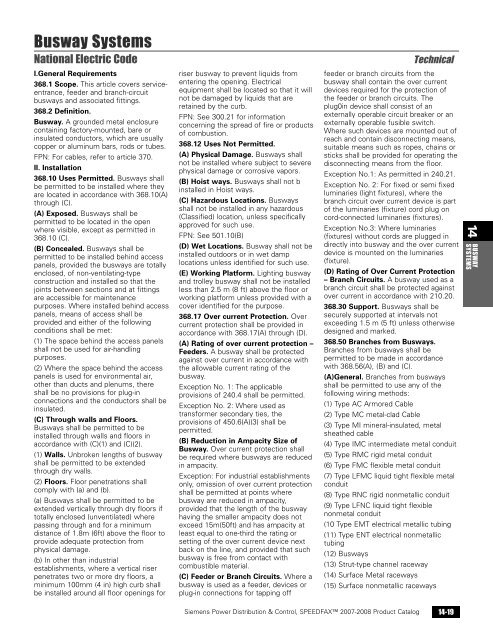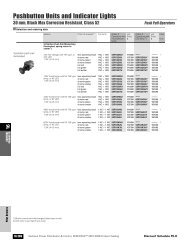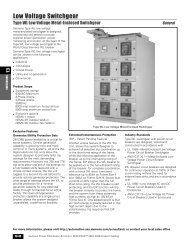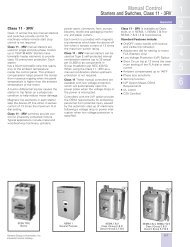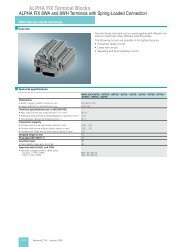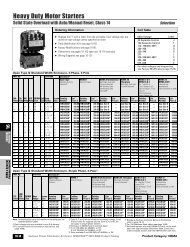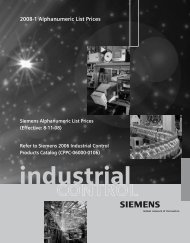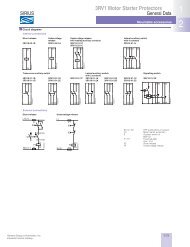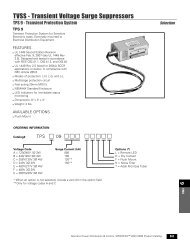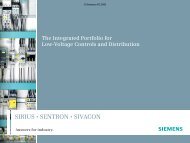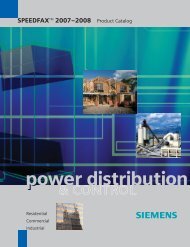Busway Systems - Siemens
Busway Systems - Siemens
Busway Systems - Siemens
Create successful ePaper yourself
Turn your PDF publications into a flip-book with our unique Google optimized e-Paper software.
<strong>Busway</strong> <strong>Systems</strong>National Electric CodeI.General Requirements368.1 Scope. This article covers serviceentrance,feeder and branch-circuitbusways and associated fittings.368.2 Definition.<strong>Busway</strong>. A grounded metal enclosurecontaining factory-mounted, bare orinsulated conductors, which are usuallycopper or aluminum bars, rods or tubes.FPN: For cables, refer to article 370.II. Installation368.10 Uses Permitted. <strong>Busway</strong>s shallbe permitted to be installed where theyare located in accordance with 368.10(A)through (C).(A) Exposed. <strong>Busway</strong>s shall bepermitted to be located in the openwhere visible, except as permitted in368.10 (C).(B) Concealed. <strong>Busway</strong>s shall bepermitted to be installed behind accesspanels, provided the busways are totallyenclosed, of non-ventilating-typeconstruction and installed so that thejoints between sections and at fittingsare accessible for maintenancepurposes. Where installed behind accesspanels, means of access shall beprovided and either of the followingconditions shall be met:(1) The space behind the access panelsshall not be used for air-handlingpurposes.(2) Where the space behind the accesspanels is used for environmental air,other than ducts and plenums, thereshall be no provisions for plug-inconnections and the conductors shall beinsulated.(C) Through walls and Floors.<strong>Busway</strong>s shall be permitted to beinstalled through walls and floors inaccordance with (C)(1) and (C)(2).(1) Walls. Unbroken lengths of buswayshall be permitted to be extendedthrough dry walls.(2) Floors. Floor penetrations shallcomply with (a) and (b).(a) <strong>Busway</strong>s shall be permitted to beextended vertically through dry floors iftotally enclosed (unventilated) wherepassing through and for a minimumdistance of 1.8m (6ft) above the floor toprovide adequate protection fromphysical damage.(b) In other than industrialestablishments, where a vertical riserpenetrates two or more dry floors, aminimum 100mm (4 in) high curb shallbe installed around all floor openings forriser busway to prevent liquids fromentering the opening. Electricalequipment shall be located so that it willnot be damaged by liquids that areretained by the curb.FPN: See 300.21 for informationconcerning the spread of fire or productsof combustion.368.12 Uses Not Permitted.(A) Physical Damage. <strong>Busway</strong>s shallnot be installed where subject to severephysical damage or corrosive vapors.(B) Hoist ways. <strong>Busway</strong>s shall not binstalled in Hoist ways.(C) Hazardous Locations. <strong>Busway</strong>sshall not be installed in any hazardous(Classified) location, unless specificallyapproved for such use.FPN: See 501.10(B)(D) Wet Locations. <strong>Busway</strong> shall not beinstalled outdoors or in wet damplocations unless identified for such use.(E) Working Platform. Lighting buswayand trolley busway shall not be installedless than 2.5 m (8 ft) above the floor orworking platform unless provided with acover identified for the purpose.368.17 Over current Protection. Overcurrent protection shall be provided inaccordance with 368.17(A) through (D).(A) Rating of over current protection –Feeders. A busway shall be protectedagainst over current in accordance withthe allowable current rating of thebusway.Exception No. 1: The applicableprovisions of 240.4 shall be permitted.Exception No. 2: Where used astransformer secondary ties, theprovisions of 450.6(A)(3) shall bepermitted.(B) Reduction in Ampacity Size of<strong>Busway</strong>. Over current protection shallbe required where busways are reducedin ampacity.Exception: For industrial establishmentsonly, omission of over current protectionshall be permitted at points wherebusway are reduced in ampacity,provided that the length of the buswayhaving the smaller ampacity does notexceed 15m(50ft) and has ampacity atleast equal to one-third the rating orsetting of the over current device nextback on the line, and provided that suchbusway is free from contact withcombustible material.(C) Feeder or Branch Circuits. Where abusway is used as a feeder, devices orplug-in connections for tapping offTechnicalfeeder or branch circuits from thebusway shall contain the over currentdevices required for the protection ofthe feeder or branch circuits. Theplug0in device shall consist of anexternally operable circuit breaker or anexternally operable fusible switch.Where such devices are mounted out ofreach and contain disconnecting means,suitable means such as ropes, chains orsticks shall be provided for operating thedisconnecting means from the floor.Exception No.1: As permitted in 240.21.Exception No. 2: For fixed or semi fixedluminaries (light fixtures), where thebranch circuit over current device is partof the luminaries (fixture) cord plug oncord-connected luminaries (fixtures).Exception No.3: Where luminaries(fixtures) without cords are plugged indirectly into busway and the over currentdevice is mounted on the luminaries(fixture).(D) Rating of Over Current Protection– Branch Circuits. A busway used as abranch circuit shall be protected againstover current in accordance with 210.20.368.30 Support. <strong>Busway</strong>s shall besecurely supported at intervals notexceeding 1.5 m (5 ft) unless otherwisedesigned and marked.368.50 Branches from <strong>Busway</strong>s.Branches from busways shall bepermitted to be made in accordancewith 368.56(A), (B) and (C).(A)General. Branches from buswaysshall be permitted to use any of thefollowing wiring methods:(1) Type AC Armored Cable(2) Type MC metal-clad Cable(3) Type MI mineral-insulated, metalsheathed cable(4) Type IMC intermediate metal conduit(5) Type RMC rigid metal conduit(6) Type FMC flexible metal conduit(7) Type LFMC liquid tight flexible metalconduit(8) Type RNC rigid nonmetallic conduit(9) Type LFNC liquid tight flexiblenonmetal conduit(10 Type EMT electrical metallic tubing(11) Type ENT electrical nonmetallictubing(12) <strong>Busway</strong>s(13) Strut-type channel raceway(14) Surface Metal raceways(15) Surface nonmetallic raceways14 BUSWAYSYSTEMS<strong>Siemens</strong> Power Distribution & Control, SPEEDFAX 2007-2008 Product Catalog 14-19
14BUSWAYSYSTEMS<strong>Busway</strong> <strong>Systems</strong>National Electric CodeWhere a separate equipment groundingconductor is used, connection of theequipment grounding conductor to thebusway shall comply with 250.8 and250.12.(B) Cord and Cable Assemblies.Suitable cord and cable assembliesapproved for extra-hard usage and hardusage, and listed bus drop cable shall bepermitted as branches from the buswayfor the connection of portable equipmentor the connection of stationaryequipment to facilitate their interchangein accordance with 400.7 and 400.8 andthe following conditions:(1) The cord or cable shall be attached tothe building by the approved means.(2) The length of the cord or cable forma busway plug-in device to a suitabletension take-up support device shall notexceed 1.8 m (6 ft.).(3) The cord and cable shall not beinstalled as a vertical riser from thetension take-up support device to theequipment served.(4) Strain relief cable grips shall beprovided for the cord or cable at thebusway plug-in device and equipmentterminations.Exception to (B)(2): In industrialestablishments only, where theconditions of maintenance andsupervision ensure that only qualifiedpersons service the installation, lengthsexceeding 1.8 m (6 ft.) shall bepermitted between the busway plug-indevice and the tension take-up supportdevice where the cord or cable issupported at intervals not exceeding2.5 m (8 ft.).(C) Branches from Trolley-Type<strong>Busway</strong>s. Suitable cord and cableassemblies approved for extra-hard sageor hard-usage and listed bus drop cableshall be permitted as branches fromtrolley-type busways for the connectionof moveable equipment in accordancewith 400.7 and 400.8.368.58 Dead Ends. A dead end of abusway shall be closed.368.60 Grounding. <strong>Busway</strong> shall begrounded.III. Construction368.120 Marking. <strong>Busway</strong> shall bemarked with the voltage and currentrating for which they are designed andwith the manufacturers name ortrademark in such a manner as to bevisible after installation.IV. Requirements for over 600 Volts,Nominal368.214 Adjacent and SupportingStructures. Metal enclosed buswaysshall be installed so that temperaturerise from induced circulating currents inany adjacent metallic parts will not behazardous to personnel or constitute afire hazard.368.234 Barriers and Seals.(A) Vapor Seals. <strong>Busway</strong> runs that havesections located inside and outside of abuilding shall have a vapor seal at thebuilding wall to prevent interchange ofair between indoor and outdoor sections.Exception: Vapor seals shall not berequired in forced-cooled bus.(B) Fire Barriers. Fire barriers shall beprovided where fire walls, floors andceilings are penetrated.FPN: See 300.21 for informationconcerning the spread of fire or productsof combustion.368.236 Drain Facilities. Drain plugs,filter drains or similar methods shall beprovided to remove condensed moisturefrom low points on a busway run.368.237 Ventilated Bus Enclosures.Ventilated busway enclosures shall beinstalled in accordance with Article 110,Part III and 490.24.368.238 Terminations andConnections. Where bus enclosuresterminate at machines cooled byflammable gas, seal-off bushings, bafflesor other means shall be provided toprevent accumulation of flammable gasin the busway enclosures. All conductortermination and connection hardwareshall be accessible for installation,connection and maintenance.368.239 Switches. Switching devices ordisconnecting links provided in thebusway run shall have the samemomentary rating as the busway.Disconnecting links shall be plainlymarked to be removable only when thebus is de-energized. Switching devicesthat are not load-break shall beinterlocked to prevent operation underload and disconnecting link enclosuresshall be interlocked to prevent access toenergized parts.368.240 Wiring 600 Volts or Less,Nominal. Secondary control devices andwiring that are provided as part of themetal-enclosed bus run shall beinsulated by fire-retardant barriers fromall primary circuit elements with theTechnicalexception of short lengths of wire, suchas at instrument transformer terminals.368.244 Expansion Fittings. Flexible orexpansion connections shall be providedin long, straight runs of bus to allow fortemperature expansion or contraction orwhere the busway run crosses thebuilding vibration insulation joints.368.258 Neutral. Neutral bus, whererequired shall be sized to carry all neutralload current, including harmonic currentsand shall have adequate momentary andshort circuit rating consistent withsystem requirements.368.260 Grounding. Metal-enclosedbusway shall be grounded.368.320 Marking. Each busway runshall be provided with a permanentnameplate on which the followinginformation shall be provided:(1) Rated voltage.(2) Rated continuous current; if bus isforced-cooled, both the normal forcedcooledrating and the self-cooled (notforced-cooled) rating for the sametemperature rise shall be given.(3) Rated frequency.(4) Rated impulse withstand voltage.(5) Rated 60Hz withstand voltage (dry).(6) Rated momentary current.(7) Manufacturers name or trademark.FPN: See ANSI C37.23-1987(R1991),Guide for Metal enclosed Bus andCalculating Losses in Isolated-PhaseBus, for construction and testingrequirements for metal enclosed bus.14-20<strong>Siemens</strong> Power Distribution & Control, SPEEDFAX 2007-2008 Product Catalog


